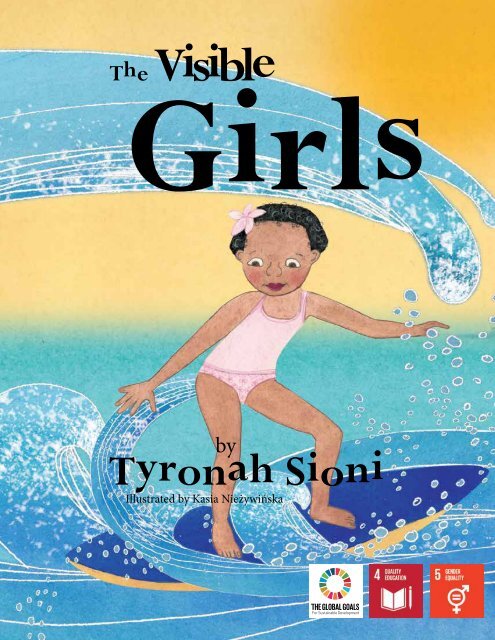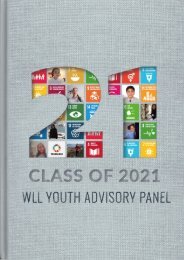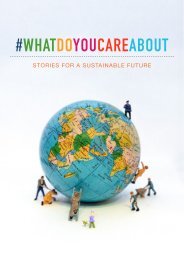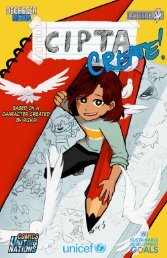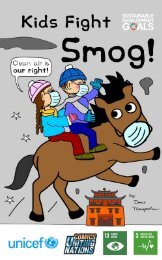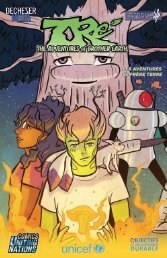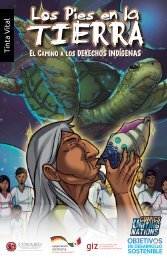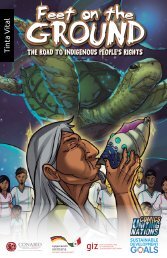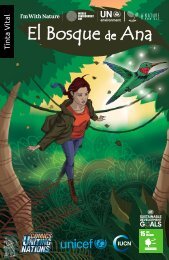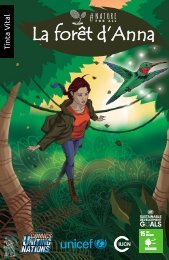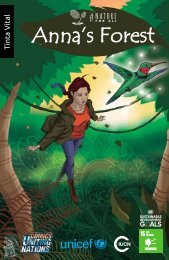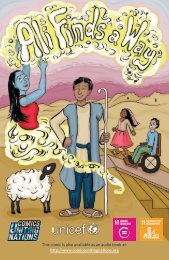The Visible Girls
You also want an ePaper? Increase the reach of your titles
YUMPU automatically turns print PDFs into web optimized ePapers that Google loves.
<strong>Girls</strong><br />
<strong>The</strong> <strong>Visible</strong><br />
by<br />
Tyronah Sioni<br />
Illustrated by Kasia Nieżywińska<br />
1
Published and distributed by:<br />
Voices of Future Generations International Children’s Book Series<br />
Trust for Sustainable Living<br />
Hampstead Norreys, Berkshire, RG18 0TN, United Kingdom<br />
Tel: +44 (0)1635 202444<br />
Web: www.vofg.org<br />
Special thanks to René V. Steiner for layout and graphics support:<br />
www.steinergraphics.com.<br />
Text © Tyronah Sioni 2017<br />
Illustrations © Kasia Nieżywińska 2017<br />
<strong>The</strong> Voices of Future Generations International Children’s Book Series:<br />
‘<strong>The</strong> Epic Eco-Inventions’ by Jona David (Europe/North America), illustrated by Carol Adlam<br />
‘<strong>The</strong> Great Green Vine Invention’ by Jona David (Europe/North America), illustrated by Carol Adlam<br />
‘<strong>The</strong> Tree of Hope’ by Kehkashan Basu (Middle East), illustrated by Karen Webb-Meek<br />
‘<strong>The</strong> Fireflies After the Typhoon’ by Anna Kuo (Asia), illustrated by Siri Vinter<br />
‘<strong>The</strong> Species-Saving Time Team’ by Lautaro Real (Latin America), illustrated by Dan Ungureanu<br />
‘<strong>The</strong> Sisters’ Mind Connection’ by Allison Lievano-Gomez (Latin America), illustrated by Oscar Pinto<br />
‘<strong>The</strong> Forward and Backward City’ by Diwa Boateng (Africa), illustrated by Meryl Treatner<br />
‘<strong>The</strong> Voice of an Island’ by Lupe Vaai (Pacific Islands), illustrated by Li-Wen Chu<br />
‘<strong>The</strong> <strong>Visible</strong> <strong>Girls</strong>’ by Tyronah Sioni (Pacific Islands), illustrated by Kasia Nieżywińska<br />
‘<strong>The</strong> Mechanical Chess Invention’ by Jona David (Europe/North America), illustrated by Dan Ungureanu<br />
CISDL<br />
Centre for International<br />
Sustainable Development Law<br />
This book is printed on recycled paper, using sustainable and low-carbon printing methods.
<strong>The</strong><br />
<strong>Visible</strong> <strong>Girls</strong><br />
by<br />
Tyronah Sioni<br />
3
4
prefaces<br />
This book is a wonderful example of a child’s brilliantly<br />
insightful and creative comment on gender equality<br />
issues in her home region. Tyronah’s story of Sine and the<br />
work she does to create and mobilise support for a gender<br />
equality programme is an important comment about the<br />
pledge in the UN Convention on the Rights of the Child<br />
to eliminate violence and discrimination against women<br />
and girls.<br />
<strong>The</strong> Voices of Future Generations Children’s Book Series<br />
offers a perfect platform for children’s views to be heard. It is inspiring to see how<br />
issues of children’s human rights are important to this generation and it’s exciting to<br />
hear how they envisage positive futures. Tyronah’s vision should be an inspiration to<br />
us all.<br />
Melinda Beier Manuel<br />
Goodwill Ambassador for the Small Island States, Voices of Future Generations<br />
5
6
What an honour and joy it is to introduce this lyrical, imaginative<br />
and courageous book by Tyronah Sioni. Tyronah is an unusually<br />
bright, sensitive and gifted young author, whose ideas and<br />
commitment will surely shape the future of her country of origin,<br />
Papua New Guinea, her region, and our shared Earth. At the tender<br />
age of 9, Tyronah is already deeply concerned about a range of global<br />
crises like environmental degradation, pollution, corruption and<br />
discrimination, and she is personally engaged in addressing them.<br />
Tyronah’s powerful story voices her concern about the condition of<br />
girls and women, in her country, and in the world at large. Through<br />
her eloquently crafted narrative, Tyra, as she is known to her friends, makes accessible to readers,<br />
young and old, UN conventions and goals on gender equality that may otherwise seem remote. She<br />
brings to life in a heartwarmingly direct way the collaboration between governments and civil society,<br />
and the active participation of young people, that is essential for realising the promises inherent in<br />
these Conventions, and securing human and planetary rights for current and future generations.<br />
Storytelling is among the most ancient of human arts and remains to this day one of the most effective<br />
ways to bring about change. Tyra already masters this art with grace and ease, not just captivating but<br />
also activating her readers. She shows that it is possible for even a powerless bystander to take a stand<br />
against injustice and discrimination. More importantly, she shows that when our conscience is awakened<br />
to injustice, it is not enough to simply protest; she suggests that we can and must find creative and<br />
innovative ways to transform the injustice. She illustrates that while there will always be challenges and<br />
obstacles faced when one pioneers change in new ways, there will also be allies along the way to support<br />
and champion changemakers, and to make the seemingly impossible possible - and in this case, the<br />
invisible visible!<br />
What moved me so deeply in Tyra’s book is the depth of her wisdom and foresight in taking her<br />
readers on a threefold journey through this short story. She enables readers to witness the reality of<br />
the mistreatment of women and girls in all our societies. She then awakens readers to the possibility of<br />
effecting change in society by starting with themselves. She finally activates their creative capacity to find<br />
new solutions and become engaged actors of change. With her mere 9 years of experience on Earth, Tyra<br />
has uncovered the secrets of societal transformation that have taken me 27 years of experience working<br />
in global governance, justice, peace and security to uncover! ‘<strong>The</strong>atre of Transformation’, which emerged<br />
from my profound human encounters in countries in conflict around the world, as a vehicle to transform<br />
today’s multiple global crises into positive opportunities, also uses the medium of storytelling, and takes<br />
participants on a similar threefold journey of transformation to Tyra’s: to witness what is; to awaken what<br />
can be; and enact the change that is needed in ourselves and in our world.<br />
Bravo Tyra! And thank you for this compelling invitation to us all to transform the world with our<br />
imagination and conviction!<br />
Rama Mani<br />
Councillor, World Future Council
8
chapter<br />
1<br />
<strong>The</strong>re was once a girl named Sine. Sine loved to draw and loved swimming.<br />
Sine was a fierce and independent yet friendly girl who was always ready to<br />
help anything or anyone in danger. She loved her island. She lived on a small<br />
island a bit far from Port Moresby with her mother, in a small village. It was all<br />
they could afford after her father died. She had a best friend named Kaimon,<br />
who was the truest, kindest and bravest person she knew. <strong>The</strong> only trouble with<br />
Kaimon was that other people, for some reason, could not see or hear her.<br />
9
One day as Sine and Kaimon were getting off<br />
the boat, which took them to their school in a<br />
neighbouring island, they saw something a bit<br />
strange. <strong>The</strong>y were passing a shop on the docks.<br />
<strong>The</strong>y saw a man shouting at a woman, forcing<br />
her out of the shop, until the woman was lying<br />
helplessly on the ground. <strong>The</strong> man looked very<br />
selfish and arrogant.<br />
10
Kaimon nudged Sine, telling her that they simply<br />
must do something. Sine trembled a bit but then<br />
regained her confidence. She raced over and told<br />
the loud man to stop. <strong>The</strong> man stopped, rolled his<br />
eyes, and returned to the shop. <strong>The</strong> woman got up<br />
slowly and limped away. Nobody said anything.<br />
11
Sine walked the rest of the way to school. She kept<br />
thinking about what they had witnessed and how<br />
wrong it was. Her mother always told her that<br />
respecting other people is very important. How<br />
was it possible that a lady was treated so and that<br />
no one could stand up for her but two small girls,<br />
one of whom no one could even see?<br />
12
13
chapter<br />
2<br />
After many lessons and much worry,<br />
Sine decided to tell her school<br />
Principal what had happened. <strong>The</strong><br />
Principal was kind and thanked her<br />
for talking about it. She explained<br />
that violence and discrimination<br />
against women and girls is<br />
forbidden in the UN Convention<br />
on the Rights of the Child.<br />
14
It remained, however, a major problem in many island communities and<br />
countries. Sine remembered seeing something on the news about groups<br />
who worked to educate people about this problem and helped to find<br />
solutions.<br />
15
That afternoon, Sine threw her schoolbag over her shoulder and left the tall<br />
front doors of her school with Kaimon. <strong>The</strong>y went straight to the island library<br />
to do some further research on the problem. <strong>The</strong>y learned many things about<br />
how women and girls can be mistreated. <strong>The</strong>y began to understand that turning<br />
their backs, and pretending to be invisible, was exactly the wrong way to change<br />
things.<br />
As Sine went to bed that night, she thought about what the two girls might do.<br />
She dreamed that Kaimon and Sine worked together to create an education<br />
programme about Women’s Rights. She even saw their motto “Women Forever,<br />
<strong>Girls</strong> Together (WFGT)” painted in bright colour on a big banner.<br />
16
17
<strong>The</strong> next day, Sine and Kaimon went straight to<br />
their Principal’s office. Sine asked permission to<br />
speak on women’s rights and gender equality in<br />
their School Assembly, as a first step in starting<br />
a new children’s education radio programme<br />
for girls and women. <strong>The</strong> Principal agreed. Sine<br />
worked hard to prepare her presentation, taking on<br />
more research, and practising with Kaimon who<br />
gave her lots of advice. On the day of her speech,<br />
she was very nervous. Kaimon encouraged her,<br />
telling her to be brave. <strong>The</strong>y had to do something,<br />
after all. And since Sine was visible, the task of<br />
speaking out was hers! Sine wished that Kaimon<br />
could also have a voice, and be seen, so that she<br />
could help. But she knew it was impossible.<br />
18
During assembly, Sine felt alone at first, but she spoke in a clear voice. She<br />
explained that women do have rights and should be able to live without<br />
fear or violence, and to participate without discrimination. She told a story<br />
that everyone could understand.<br />
19
At the end, she encouraged everyone to stand up<br />
for their rights. She challenged everyone to help<br />
create a new educational programme with her.<br />
<strong>The</strong>re were many smiles, and nods as she finished.<br />
Kaimon cheered the loudest, even though Sine<br />
was the only one who could hear her.<br />
20
<strong>The</strong> Principal, teachers, and students agreed to<br />
support the new programme. <strong>The</strong> Principal thought<br />
it would be a great opportunity for the school,<br />
students, and for the country’s development.<br />
21
chapter<br />
3<br />
Sine worked hard with her friends to hang up flyers all around the village. <strong>The</strong><br />
flyers were bright and colourful. <strong>The</strong>y explained all the activities and games for<br />
the WFGT education activities. Every day, more and more members joined.<br />
Most of them were girls, but after a while, boys also joined.<br />
22
<strong>The</strong>y started the children’s radio programme and<br />
held interviews with all the women leaders in their<br />
community, asking them questions and seeking<br />
ideas for things that girls could do to help improve<br />
their village. Kaimon could participate more that<br />
way because, even though she was still invisible, her<br />
voice was getting stronger. Sometimes when it was<br />
only Sine and Kaimon in the studio, she would speak<br />
out about the things she cared about, and people<br />
started to hear her.<br />
23
Before long, even adult women and men were<br />
asking if they could join. Sine always said “<strong>The</strong><br />
more, the merrier!” And Kaimon would dance in<br />
excitement.<br />
24
Soon, all the women and most of the men in the<br />
village had signed up. <strong>The</strong>y were becoming very<br />
active, even starting their own little projects. Many<br />
of the girls and women started their own small<br />
businesses, growing flowers or vegetables to sell,<br />
raising chickens and delivering eggs to families for<br />
breakfast, painting pictures and carving sculptures,<br />
even making necklaces out of shells. One woman<br />
had the idea to begin a tiny new savings bank, so<br />
that all the women could borrow money to start<br />
gardens or crafts, then pay it back to be lent out to<br />
help others.<br />
25
One afternoon, Kaimon and Sine were leading their radio programme and<br />
taking calls from girls all over the island who wanted to share stories of<br />
their activities. <strong>The</strong>y were playing a song while they rested their voices,<br />
when the telephone rang.<br />
26
It was a friend called Tau and he wanted to arrange<br />
a meeting with the Prime Minister so that Sine<br />
could tell him what the group was doing. Sine felt<br />
all nervous again, but Kaimon didn’t hesitate. She<br />
answered right away “That would be awesome!”<br />
And then the music ended, so straight away, Sine<br />
announced over the radio that the Women’s Rights<br />
group would be meeting the Prime Minister.<br />
Everyone was surprised, but also very proud. And<br />
they knew they couldn’t back down now.<br />
27
chapter<br />
4<br />
<strong>The</strong> next morning, Sine<br />
and Kaimon woke up<br />
early. Sine’s mother had<br />
made her favourite:<br />
bananas and fish! After<br />
breakfast, she went<br />
down to the beach for a<br />
bath.<br />
28
She saw her friends in the waters near her but did<br />
not stop to say hello, as her mind was too busy. Sine<br />
and Kaimon played in the warm waves together<br />
to help each other calm down.<br />
29
<strong>The</strong>y could see leaping silver dolphins just beyond<br />
the breakwater, and this filled them with happiness.<br />
30
When they arrived back at the house, a visitor was<br />
waiting. Sine’s mother was sitting on the mat in<br />
front of him. It was Tau, the friend who had called<br />
them on the radio. Tau had very exciting news for<br />
Sine and Kaimon – the meeting was arranged and<br />
the girls would travel all the way to Port Moresby<br />
to meet the Prime Minister of their country.<br />
31
32
33
Sine was terribly excited and nervous all over again. She glanced at Kaimon,<br />
asking silently for reassurance. Tau looked too, and then asked Kaimon<br />
directly, “And what would you like to say to the leader of your country, little<br />
brave one?” Kaimon smiled and answered gaily: “I’ll just explain that there is<br />
strength in all of us. When the girls of Papua New Guinea come together and<br />
stand up for each other, we can change the world.” Sine nearly jumped two<br />
miles in the air. She was amazed! It was the first time that anyone - except<br />
her - had really been able to see Kaimon.<br />
34
Sine felt her heart fill with joy. She was happy<br />
that people were finally recognising their girls’<br />
education programme and all the efforts of the<br />
group to bring boys and girls together for a better<br />
village. And she was surprised but overjoyed that<br />
her best friend, who had always been quietly beside<br />
her and supporting her, was finally becoming…<br />
visible!<br />
35
<strong>The</strong> next morning, the girls were woken up by<br />
the sound of crashing waves. <strong>The</strong>y prepared<br />
quickly and Tau knocked on the door an hour<br />
later. <strong>The</strong>y stopped at their local market to<br />
pick up some supplies, then travelled all the<br />
way to Port Moresby. Kaimon laughed and<br />
told stories for the whole trip and Sine loved<br />
it, because Tau really answered. He could see<br />
Kaimon and understand her, too!<br />
36
chapter<br />
5<br />
Before they knew it, they<br />
had arrived at the Prime<br />
Minister’s office. Tau<br />
pressed the doorbell and<br />
stood there with a large<br />
grin on his face, while Sine<br />
became very nervous again.<br />
Kaimon gave her a quick<br />
hug in reassurance and then<br />
straightened up politely.<br />
37
<strong>The</strong> large wooden door opened and a tall thin man<br />
with his nose high up in the air led them to an<br />
elegant office. <strong>The</strong>y quietly entered through the<br />
door and approached the Prime Minister. He was<br />
sitting comfortably in a large cushiony chair at<br />
the end of a bulky, wooden, oval shaped table in a<br />
bright room with lots of certificates and carvings<br />
on the wall.<br />
38
Tau was the first to say hello. <strong>The</strong>n the Prime Minister turned to Sine and Kaimon,<br />
saying welcome. Sine answered with a trembling voice and Kaimon smiled brightly,<br />
but said nothing. Sine was terrified that her friend had disappeared again. But the<br />
Prime Minister asked both girls to sit down in the chairs diagonally next to him.<br />
39
He had heard about the WFGT programmes on<br />
the radio show and he was interested in what they<br />
were doing. Sine told him about their mission<br />
to improve awareness of women’s rights in the<br />
community and eventually the whole country.<br />
Kaimon added that women are citizens of this<br />
planet, too.<br />
40
<strong>The</strong> Prime Minister was delighted. He was proud of the girls and everything<br />
that they had done. He was also happy because, as he explained, it was his<br />
mission to make sure that girls and women never felt frightened or silenced<br />
again. He had just been to New York, he explained, to the United Nations,<br />
and world leaders had agreed on Sustainable Development Goals for the<br />
whole planet.<br />
41
42
Gender equality, and participation of girls and<br />
women in the community, were two of the most<br />
important goals that the world leaders had<br />
committed to achieve. As soon as I heard your<br />
radio programme, I realised that it won’t be as hard<br />
as I thought for my country, he admitted. “With<br />
<strong>Visible</strong> <strong>Girls</strong> like you on our side, we’ll meet our<br />
goals, and I believe that we’ll even have fun doing<br />
it!” Kaimon’s smile was brilliant and Sine nearly<br />
cried for joy. By standing up for themselves and<br />
for each other, they could help make the world<br />
better for everyone.<br />
<strong>The</strong> End<br />
43
about<br />
the<br />
author<br />
Tyronah Sioni (9) is originally from Papua New Guinea. She<br />
lives in Singapore with her father and her three brothers. She<br />
is a pupil of the Australian International School. Everyone<br />
calls her Tyra. She is in the 4th grade and the President of her<br />
class. She likes singing and dancing but most of all, she loves<br />
helping the planet. She hopes one day to create a worldwide<br />
charity called Evergreen. Her charity will help people in need,<br />
especially those who can’t afford food and homes. It will also<br />
help to decrease pollution and solve environmental problems,<br />
teaching us not to take too much of something, such as<br />
overfishing. She also dreams of working to investigate and fight corruption, discrimination,<br />
and harassment. She plans to try her hardest and her best to make these simple dreams an<br />
amazing reality.<br />
44
about<br />
the<br />
illustrator<br />
Kasia Nieżywińska was born in Poland and moved to the<br />
UK some 25 years ago. Her background is in mathematics.<br />
She has worked as a teacher, a computer programmer and<br />
recently as a freelance illustrator. Her special interest is in<br />
creating images for children’s books. She qualified with a MA<br />
Degree in Children’s Book Illustration from Ruskin University<br />
in Cambridge. <strong>The</strong> ideas for her work come predominantly<br />
from her childhood memories, through which she recalls and<br />
sometimes imagines her own adventures. She loves telling<br />
stories and illustrating them.<br />
45
<strong>The</strong> United Nations Convention on the Rights of the Child<br />
All children are holders of important human rights. Twenty-five<br />
years ago in 1989, over a hundred countries agreed a UN Convention<br />
on the Rights of the Child. In the most important human rights<br />
treaty in history, they promised to protect and promote all children’s<br />
equal rights, which are connected and equally important.<br />
In the 54 Articles of the Convention, countries make solemn<br />
promises to defend children’s needs and dreams. <strong>The</strong>y recognize<br />
the role of children in realizing their rights, being heard and<br />
involved in decisions. Especially, Article 24 and Article 27 defend<br />
children’s rights to safe drinking water, good food, a clean and safe<br />
environment, health, quality of life. And Article 29 recognizes<br />
children’s rights to education that develops personality, talents and<br />
potential, respecting human rights and the natural environment.<br />
— Dr. Alexandra Wandel<br />
World Future Council<br />
46
<strong>The</strong> UN Sustainable Development Goals<br />
At the United Nations Rio+20 Conference on Sustainable Development<br />
in 2012, governments and people came together to find pathways<br />
for a safer, more fair, and greener world for all. Everyone agreed to<br />
take new action to end poverty, stop environmental problems, and<br />
build bridges to a more just future. In 283 paragraphs of <strong>The</strong> Future<br />
We Want Declaration, countries committed to defend human rights,<br />
steward resources, fight climate change and pollution, protect<br />
animals, plants and biodiversity, and look after oceans, mountains,<br />
wetlands and other special places.<br />
In the United Nations, countries are committing to 17 new<br />
Sustainable Development Goals for the whole world, with targets<br />
for real actions on the ground. Clubs, governments, firms, schools<br />
and children have started over a thousand partnerships, and<br />
mobilized billions, to deliver. <strong>The</strong> future we want exists in the<br />
hearts and minds of our generation, and in the hands of us all.<br />
— Vuyelwa Kuuya<br />
Centre for International Sustainable Development Law (CISDL)<br />
47
Thanks and Inspiring Resources<br />
‘Voices of Future Generations’ International Commission<br />
Warmest thanks to the International Commission, launched in 2014 by His Excellency Judge CG<br />
Weeramantry, UNESCO Peace Education Research Award Laureate, which supports, guides and profiles<br />
this new series of Children’s Books Series, including Ms Alexandra Wandel (WFC), Dr Marie-Claire<br />
Cordonier Segger (CISDL), Dr Kristiann Allen (New Zealand), Ms Irina Bokova (UNESCO), Mr Karl<br />
Hansen (Trust for Sustainable Living), Ms Emma Hopkin (UK), Dr Ying-Shih Hsieh (EQPF), Dr Maria<br />
Leichner-Reynal (Uruguay), Ms Melinda Manuel (PNG), Ms Julia Marton-Lefevre (IUCN), Dr James<br />
Moody (Australia), Ms Anna Oposa (<strong>The</strong> Philippines), Professor Kirsten Sandberg (UN CRC Chair),<br />
Ms Patricia Chaves (UN DSD), Dr Marcel Szabo (Hungary), Dr Christina Voigt (Norway), Ms Gabrielle<br />
Sacconaghi-Bacon (Moore Foundation), Ms Marcela Orvañanos de Rovzar (UNICEF Mexico) and others.<br />
<strong>The</strong> World Future Council consists of 50 eminent global changemakers from across the globe. Together,<br />
they work to pass on a healthy planet and just societies to our children and grandchildren. (www.<br />
worldfuturecouncil.org)<br />
United Nations Education, Science and Culture Organization (UNESCO) which celebrates its 70th<br />
Anniversary throughout 2015, strives to build networks among nations that enable humanity’s moral<br />
and intellectual solidarity by mobilizing for education, building intercultural understanding, pursuing<br />
scientific cooperation, and protecting freedom of expression. (en.unesco.org)<br />
<strong>The</strong> United Nations Committee on the Rights of the Child (CRC) is the body of 18 independent experts<br />
that monitors implementation of the Convention on the Rights of the Child, and its three Optional<br />
Protocols, by its State parties. (www.ohchr.org)<br />
United Nations Environment Programme (UNEP) provides leadership and encourages partnership in<br />
caring for the environment by inspiring, informing, and enabling nations and peoples to improve their<br />
quality of life without compromising that of future generations. (www.unep.org)<br />
International Union for the Conservation of Nature (IUCN) envisions a just world that values and<br />
conserves nature, working to conserve the integrity and diversity of nature and to ensure that any use of<br />
natural resources is equitable and ecologically sustainable. (www.iucn.org)<br />
Centre for International Sustainable Development Law (CISDL) supports understanding, development<br />
and implementation of law for sustainable development by leading legal research through scholarship and<br />
dialogue, and facilitating legal education through teaching and capacity-building. (www.cisdl.org)<br />
Trust for Sustainable Living and its Living Rainforest Centre exist to further the understanding<br />
of sustainable living in the United Kingdom and abroad through high-quality education. (www.<br />
livingrainforest.org)<br />
Environmental Quality Protection Foundation (EQPF) established in 1984 is the premier ENGO in Taiwan.<br />
Implementing environmental education, tree plantation, 48 and international participation through coordinating<br />
transdisciplinarity resources to push forward environmental and sustainable development in our time.
About the ‘Voices of Future Generations’ Series<br />
To celebrate the 25th Anniversary of the United Nations Convention on the Rights of the Child, the<br />
Voices of Future Generations Children’s Book Series, led by the United Nations and a consortium of<br />
educational charities including the World Future Council (WFC), the Centre for International Sustainable<br />
Development Law (CISDL), the Environmental Quality Protection Foundation (EQPF), the Fundacion<br />
Ecos and the Trust for Sustainable Living (TSL) among others, also the Future Generations Commissioners<br />
of several countries, and international leaders from the UN Division for Sustainable Development, the UN<br />
Committee on the Rights of the Child, the UN Education, Science and Culture Organisation (UNESCO),<br />
the International Union for the Conservation of Nature (IUCN), and other international organizations,<br />
has launched the new Voices of Future Generations Series of Children’s Books.<br />
Every year we feature stories from our selected group of child authors, inspired by the outcomes of the<br />
Earth Summit, the Rio+20 United Nations Conference on Sustainable Development (UNCSD) and<br />
the world’s Sustainable Development Goals, and by the Convention on the Rights of the Child (CRC)<br />
itself. Our junior authors, ages 8-12, are concerned about future justice, poverty, the global environment,<br />
education and children’s rights. Accompanied by illustrations, each book profiles creative, interesting and<br />
adventurous ideas for creating a just and greener future, in the context of children’s interests and lives.<br />
We aim to publish the books internationally in ten languages, raising the voices of future generations and<br />
spread their messages for a fair and sustainable tomorrow among their peers and adults, worldwide. We<br />
welcome you to join us in support of this inspiring partnership, at www.vofg.org.<br />
49
50
51
52
53
54
55
It is a long way from Papua New Guinea to the United Nations<br />
General Assembly in New York for a nine-year-old, but Tyra is<br />
no ordinary girl. <strong>The</strong> gold certificate that she was awarded there<br />
for this wonderful story is something she should surely feel very<br />
proud of.<br />
Alexander Rheeney<br />
Editor, Post Courier Newspaper, Papua New Guinea<br />
Tyra writes with intelligence on the issues facing women and girls<br />
in her home country and around the world. This is a wonderful<br />
book, which gets to the heart of gender equality as a crucial part<br />
of the Convention of the Rights of the Child.<br />
Professor Kristen Sandberg<br />
Former Chair, UN Commission on the Rights of the Child<br />
It is a pleasure to see this inspirational book as part of the Voices<br />
of Future Generations children’s book series. Beautifully written,<br />
it contains lessons that we all can learn from.<br />
Professor Marcel Szabó<br />
Commissioner for Future Generations, Hungary<br />
UNESCO Voices of Future Generations | Children’s Book Series 7<br />
<strong>The</strong> <strong>Visible</strong> <strong>Girls</strong> | 1


